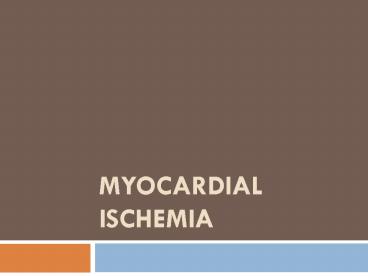Myocardial Ischemia - PowerPoint PPT Presentation
1 / 23
Title:
Myocardial Ischemia
Description:
MYOCARDIAL ISCHEMIA Ischemia Is when blood flow to the myocardium is insufficient to maintain the metabolic demand of the myocytes. Transmural Ischemia The hallmark ... – PowerPoint PPT presentation
Number of Views:43
Avg rating:3.0/5.0
Title: Myocardial Ischemia
1
Myocardial Ischemia
2
Ischemia
- Is when blood flow to the myocardium is
insufficient to maintain the metabolic demand of
the myocytes. - Transmural Ischemia
- The hallmark of acute transmural ischemia (across
the heart wall from endocardium to epicardium )
is the elevation of the ST segment of the ECG. - This is visualized by the ST-segment being
raised above the isoelectric baseline. - This is due to a higher (more positive) resting
voltage of ischemic cells.
3
- Which cause the ST-segment baseline to be more
positive (an upwards deflection). - This change in the ST segment is mostly localized
in the lead most directly overlying the ischemic
myocardial area. - This may lead to unstable angina, and should be
taken very seriously, as this is the condition
that progresses to an acute MI. - As the ischemia becomes more extensive the ST
segment elevation becomes more pronounced.
4
ST-Segment Elevation
5
- Sub-Endocardial Ischemia
- Relative decreased flow in the subendocardial
regions is a normal consequence of the squeezing
of the myocardium, which compresses the blood
supply to the endocardium during ventricular
systole. - However, this can also be a pathological
condition, expressed in stable-angina. This is a
condition where the myocardial demands exceed the
coronary artery blood supply .
6
- This is represented on the ECG as ST-segment
depression. - The ischemic cells become more positive in their
resting voltage (due to channel leakage) and this
makes the subendocardium more positive since the
endocardium is further away from the precordial
leads than the more negative mycardium we see
this as a depression .
7
ST-Segment Depression in subendocardial ischemia
8
ECG showing depressed S-T segment (ischemia)
9
- After the ischemia has progressed to an infarct,
and the tissue has scarred, the ECG will show - Q wave Necrosis (significant Qs only)
- Significant Q wave is one millimeter (one small
square) wide, which is .04 sec. in duration or
more or is a Q wave gt1/4the amplitude (or more)
of the QRS complex. - Old infarcts significant Q waves (like infarct
damage) remain for a lifetime.
10
- ST (segment) elevation (acute) Injury)
- Signifies an acute process, ST segment returns to
baseline with time. - T wave inversion Ischemia
- Inverted T wave (of ischemia) is symmetrical
(left half and right half are mirror images).
Normally T wave is upright when QRS is upright,
and vice versa. - Usually in the same leads that demonstrate signs
of acute infarction (Q waves and ST elevation).
11
Q-waves with Inverted T-Waves
12
(No Transcript)
13
- Infarction Location
- Lateral
- Qs in lateral leads I and AVL (Circumflex
Coronary Artery). - Anterior
- Qs in V1, V2, V3, and V4 (Anterior Descending
- Coronary Artery)
- Inferior (diaphragmatic)
- Qs in inferior leads II, III, and AVF (R. or L.
Coronary Artery).
14
(No Transcript)
15
(No Transcript)
16
(No Transcript)
17
(No Transcript)
18
(No Transcript)
19
(No Transcript)
20
(No Transcript)
21
(No Transcript)
22
(No Transcript)
23
(No Transcript)































